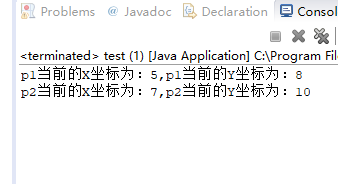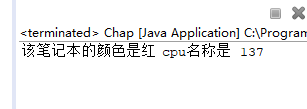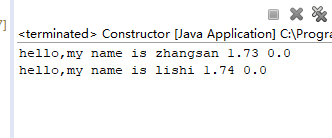1、定义一个点类Point,包含2个成员变量x、y分别表示x和y坐标,2个构造器Point()和Point(intx0,y0),以及一个movePoint(int dx,int dy)方法实现点的位置移动,创建两个Point对象p1、p2,分别调用movePoint方法后,打印p1和p2的坐标。[必作题]
package nine; public class point { int x; int y; point() { } point(int x0, int y0) { this.x = x0; this.y= y0; } void movePoint(int dx,int dy) { this.x += dx; this.y += dy; } }
package nine; public class test { public static void main(String[] args) { // TODO Auto-generated method stub point p1 = new point(1, 3); p1.movePoint(4, 5); System.out.println("p1当前的X坐标为:" + p1.x + ",p1当前的Y坐标为:" + p1.y); point p2 = new point(2,2); p2.movePoint(5, 8); System.out.println("p2当前的X坐标为:" + p2.x + ",p2当前的Y坐标为:" + p2.y); } }

2、定义一个矩形类Rectangle:(知识点:对象的创建和使用)[必做题]
• 2.1 定义三个方法:getArea()求面积、getPer()求
周长,showAll()分别在控制台输出长、宽、面积
、周长。
• 2.2 有2个属性:长length、宽width
• 2.3 通过构造方法Rectangle(int width, int length),
分别给两个属性赋值
• 2.4 创建一个Rectangle对象,并输出相关信息
package one; public class Rectangle { int length; int width; public Rectangle(int length, int width) { this.length = length; this.width = width; } public int getArea() { return length * width; } public int getPer() { return 2 * (length + width); } void showAll() { System.out.println("长为" + length + ",宽为" + width + ",面积为" + getArea() + ",周长为" + getPer()); } public static void main(String[] args) { Rectangle a = new Rectangle(7 ,4); a.showAll(); } }
3、定义一个笔记本类,该类有颜色(char)和cpu型号(int)两个属性。 [必做题]
• 3.1 无参和有参的两个构造方法;有参构造方法可
以在创建对象的同时为每个属性赋值;
• 3.2 输出笔记本信息的方法
• 3.3 然后编写一个测试类,测试笔记本类的各个
方法。
package nine; public class book { char color; int cpu; public void showBook() { } public void showBook(char color, int cpu) { this.color = color; this.cpu = cpu; } void showAll() { System.out.println("该笔记本的颜色是" + color + " cpu名称是 " + cpu); } }
package nine; public class Chap { public static void main(String[] args) { // TODO Auto-generated method stub book a=new book(); a.showBook('红',137); a.showAll(); } }

6、定义两个类,描述如下: [必做题]
• 6.1定义一个人类Person:
• 6.1.1定义一个方法sayHello(),可以向对方发出
问候语“hello,my name is XXX”
• 6.1.2有三个属性:名字、身高、年龄
• 6.1.3通过构造方法,分别给三个属性赋值
• 6.2定义一个Constructor类:
• 6.2.1创建两个对象,分别是zhangsan,33岁,
1.73;lishi,44,1.74
• 6.2.2分别调用对象的sayHello()方法。
package book; public class person { String name; double height; double weight; person(String name,double height,int age){ this.name=name; this.height=height; this.weight=weight; } void sayHello(){ System.out.println("hello,my name is "+name+" "+height+" "+weight); } public static void main(String[] args) { // TODO Auto-generated method stub } }
package book; public class Constructor { public static void main(String[] args) { // TODO Auto-generated method stub person a = new person("zhangsan",1.73,33); person b = new person("lishi",1.74,44); a.sayHello(); b.sayHello(); } }
